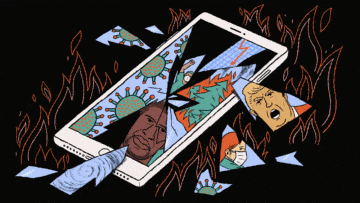Adam Gopnik in The New Yorker:
 What tone can one possibly strike for an overview of 2020? The Queen’s old label of annus horribilis for her own most troubled time hardly seems adequate. Even the right point of view is hard to decide on. Does it make more sense to see the year from high above, taking a picture of an entire panicked planet, or to start from the ant’s- or worm’s-eye view, with the transformation of our manners and minds by the strangeness of 2020 (and by its sadness, too)? Begin with the scale of the misery and dislocation? Narrow down to the specific sensory strangeness of the year?
What tone can one possibly strike for an overview of 2020? The Queen’s old label of annus horribilis for her own most troubled time hardly seems adequate. Even the right point of view is hard to decide on. Does it make more sense to see the year from high above, taking a picture of an entire panicked planet, or to start from the ant’s- or worm’s-eye view, with the transformation of our manners and minds by the strangeness of 2020 (and by its sadness, too)? Begin with the scale of the misery and dislocation? Narrow down to the specific sensory strangeness of the year?
Seeing the scale first is useful because it’s so unparalleled: not one city, or even one country, but everywhere at once. Paris shut down and the first silent nights in its history enforced, with Parisians carrying permission slips like schoolchildren just to go to a pharmacy. London under lockdown, Times Square in quarantine, dressed in ghost-town array. “A quiet capital is a contradiction in terms,” the great Max Beerbohm wrote during the London bombing. “It is a thing uncanny, spectral.” And yet, uncanny though it might be, the imagery of an actual pandemic is, truth be told, considerably less melodramatic than the cinematic version. Often, when we call something “unimaginable,” what we really mean is more like “too oft imagined.” We actually have been here before, in every pandemic movie, in that Will Smith one with the zombies, for instance—and, in the zombie movie, the people are slavering in the streets. In the real one, the streets are merely empty.
The sensory specifics are all that usually matter, or linger, in history. Read Daniel Defoe on the mid-seventeenth-century plague in London, and it is the inventory of specific people and places—how the bear-baiting pits got shut down—that is most memorable. Let’s mark down some new sensory experiences, which our descendants might find hard to credit.
More here.
